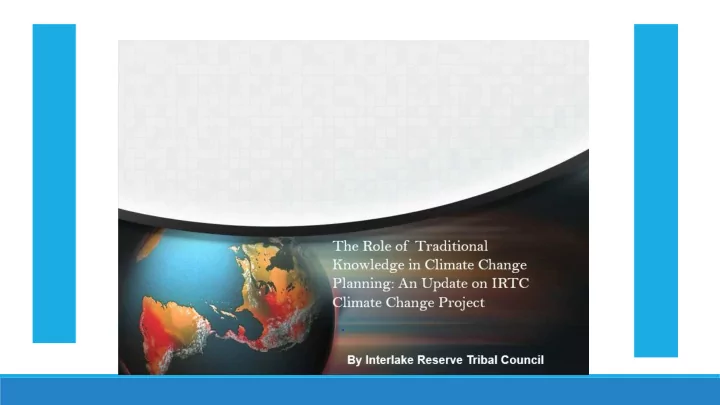

• About IRTC • Our Communities Departments •
Flooding in Pinaymootang First A once Pristine riparian zone Context Nation Climate change impacts vs Human induced impacts Climate change and Emergency management Dried up Pond Wildfire Outbreak
Project Objective : To understand current (and past) impacts of climate change by conducting a vulnerability risk assessment in order to strengthen efforts in disaster risk reduction (DRR) Stepwise approach focused on adaptation: ---- Risk management and adaptive capacity ----- Adaptation planning
Ninety- One percent of community members believe that climate change is real - Dauphin River First Nation Climate Change Perception Yes No Source: IRTC climate change project
One hundred percent of community members believe climate change is real - Peguis First Nation n = 40 Yes No Source: IRTC climate change project
Source: IRTC climate change project
Most Effective Strategy to Reduce Climate Change Impacts - Pinaymootang First Nation 35.00% 30.00% 25.00% 20.00% Adapting community planning to new climate reality 15.00% Conducting impact studes and climate forecasts 10.00% Collaborating with external experts 5.00% Raising awareness and providing training Establishing a committee on climate change 0.00% Most Effective Strategy to Reduce Climate Change Impacts
Community Risk Mapping • Using a participatory approach that integrates traditional knowledge in adaptation planning, climate risks maps were produced. • Community members, including leaders, resource users (hunters, fishermen.), and elders, were selected in the various mapping sessions organized. • Oral stories, in addition to qualitative assessments, were used to identify and assess climate hazards and its level of impact. • These data were put on the physical map provided, and later converted into GIS layers . Source: IRTC climate change project
Disclaimer: The maps shown here are still in the process of refinement, as data Source: IRTC climate change project collection and analysis are still ongoing. Subsequent iterations will be done in the next months/years
Source: IRTC climate change project
Source: IRTC climate change project
Source: IRTC climate change project
Source: IRTC climate change project
Source: IRTC climate change project
School workshops Engagement sessions Ongoing/future projects
Thank you Merci Mii’gwetch
Recommend
More recommend